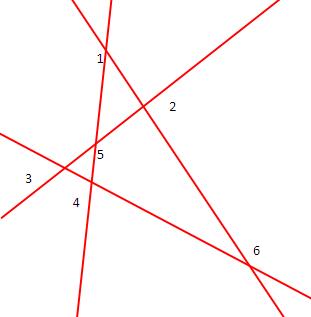 23
23errrrr..........i didnt read the question carefully......
 1
1If the paths of three snails are Straight lines which are not concurrent, then it means that the paths are all parallel. Hence if the fourth snail crosses them using a straight line path, 5 encounters are not possible at all. The maximum encounters is 3.
Either the solution is wrong, or the information in the question is incorrectly written.
 23
23no ankur , it means that max concurrent paths are 2
 1
1please explain the answer
 1
1no the ans is correct because if lines are not concurent it means atmost only 2 lines can intersect hence u will find that they can intersect only in 6 way provided they arn't parallel hence they r parallel is also be included in the question
 1
1If 5 encounters have taken place,the only way of motion is summat like dis............

This shows that, sixth encounter is possible, and certain, though not obvious...........
If I am not widely mistaken, we hav one such question in the only (2nd nt out yet [2])edition of reflections
[339]
 1
1seriously speakin even 5 encounters r not possible.coz 3 of them r not concurrent n dats y even 5 r not possible.
 1
1I proved it using vectors that sixth collision is impossible.Take pv's of s1 and s2 w.r.t. s3(s1 and s2 encounter s3).put(v1-v3)t1=-x1(vectors) and (v2-v3)t2=-x2.For common encounter of s1 ad s2,(v1-v2)t=x2-x1 which is possible only if t1=t2,but 3 s are not concurrent simultaneously,so answer is(a)
 1
1Visit www.anujkalia.blogspot.com for your daily powerful physics problems. These are neither easy nor too difficult. I bet you'll love them.
P.S.
1)Sorry for (something like) spamming.
2)The blog has been around for an year now. That gives you about a 100 thumping good problems if you scan the archives.
3)Try the blog. I would have.
4)Hi Anirudh:
The volume rate of removal of the tape is constant (assume this). Now, loss in volume in the 2nd case is 1/4 of the volume loss in the 2nd case. This yields the answer 1/4*t.
